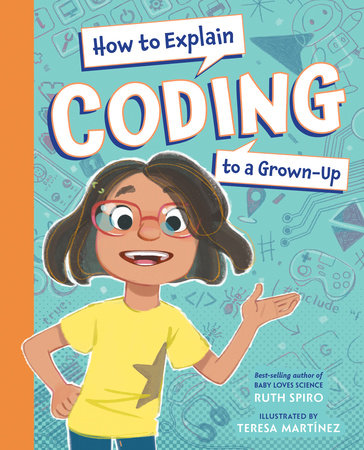The best-selling author of the Baby Loves Science series levels up with this playful STEM picture book introducing kids–and grown-ups–to the coding world.Grown-ups do NOT have all the answers! In this tongue-in-cheek guide, an in-the-know narrator instructs perceptive kid readers in the fine art of explaining coding to a grown-up. Both children and their adults learn the basics of coding, including hardware, software, algorithms, and debugging. Cleverly disguised “pro tips” suggest best practices for teaching any topic.
Fun and fact-filled, the How to Explain Science series will empower kid experts to explore complex scientific concepts with any grown-up who will listen.
On sale: October 10, 2023
Age: 4-8 years
Grade: Preschool - 3
Page count: 32 Pages
ISBN: 9781623543181
Reading level: Lexile: AD570L | Fountas/Pinnell: O
Ruth Spiro is the author of the best-selling Baby Loves Science series, which has been praised for introducing "big science to little minds with the skill of a neurosurgeon" (Matthew Winner,
All the Wonders podcast). Ruth also wrote the Made by Maxine picture-book series. She speaks regularly at STEM and early-childhood conferences across the country.
www.ruthspiro.com
When
Teresa Martínez was a child, her family moved from a small town to the city. Drawing helped shy Teresa connect with the other kids at school. Now she connects with children across Mexico and around the world through the books she illustrates, including
Mario and the Hole in the Sky;
Again, Essie?; and
Sing with Me: The Story of Selena Quintanilla.www.teresa-mtz.com
Grown-ups may not be the only audience for this simple explanation of how algorithms work.
Taking a confused-looking hipster parent firmly in hand, a child first points to all the computers around the house (“Pro Tip: When dealing with grown-ups, don’t jump into the complicated stuff too fast. Start with something they already know”). Next, the child leads the adult outside to make and follow step-by-step directions for getting to the park, deciding which playground equipment to use, and finally walking home. Along the way, concepts like conditionals and variables come into play in street maps and diagrams, and a literal bug stands in for the sort that programmers will inevitably need to find and solve. The lesson culminates in an actual sample of very simple code with labels that unpack each instruction…plus a pop quiz to lay out a decision tree for crossing the street, because if “your grown-up can explain it, that shows they understand it!” That goes for kids, too—and though Spiro doesn’t take the logical next step and furnish leads to actual manuals, young (and not so young) fledgling coders will find plenty of good ones around, such as
Get Coding! (2017), published by Candlewick, or Rachel Ziter’s
Coding From Scratch (2018).
A lighthearted first look at an increasingly useful skill. (glossary)
—Kirkus Reviews

















